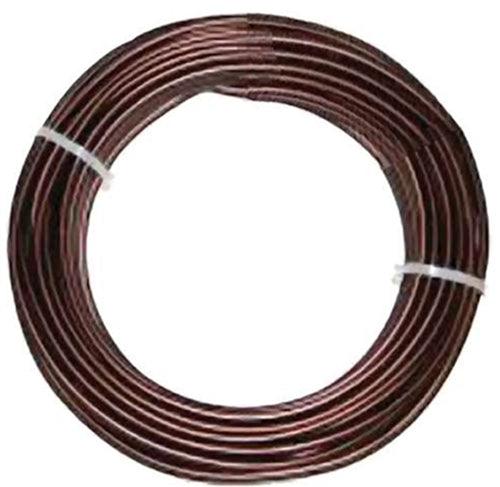Bonsai Waterfalls & Strange Beasts
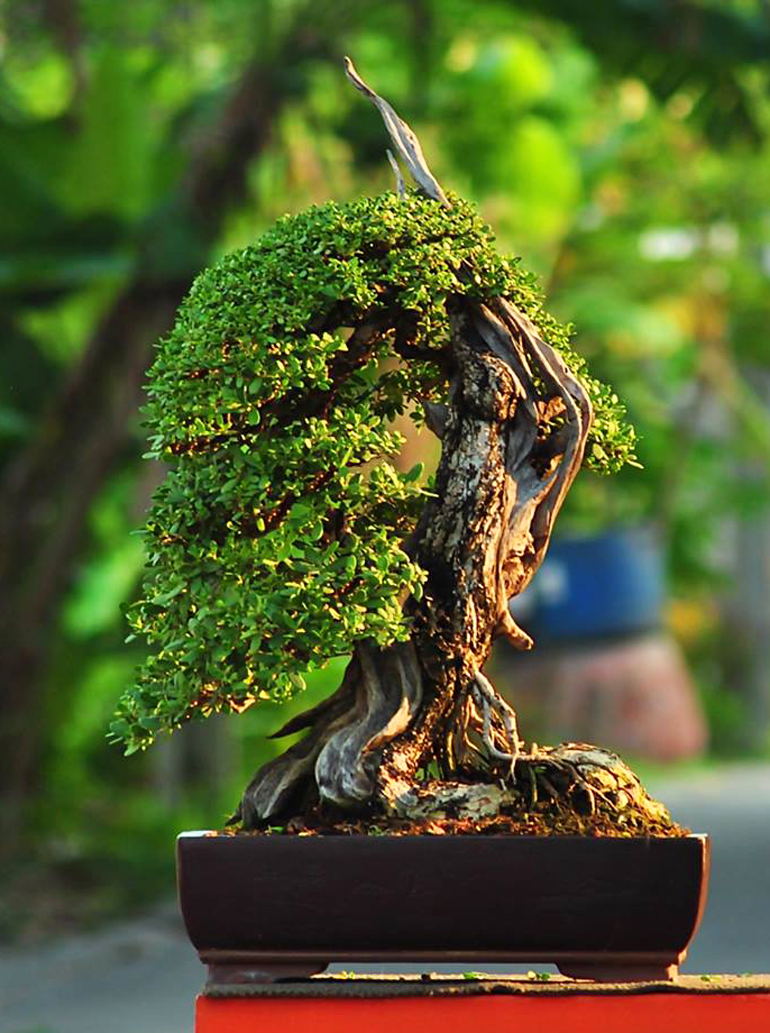
Not technically a cascading bonsai, but the foliage does cascade down along the trunk. Almost like a waterfall. Speaking of the trunk, not only does it express more than enough power and grace, but the way the grooved deadwood at the base of the trunk twists around behind and pops out again toward the top adds a nice touch. The tree is listed as Pemphis which is a genus of tropical plants. The species isn't given but when it comes to bonsai Pemphis usually (always?) mean Pemphis acidula
Today’s featured artist, Trang Jira lives in Bangkok, Thailand. His trees are unique and unlike most of the trees we show, they don’t owe that much to the Japanese bonsai tradition.* They may be closer to Chinese Penjing, but to my eye they stand on their own.
–
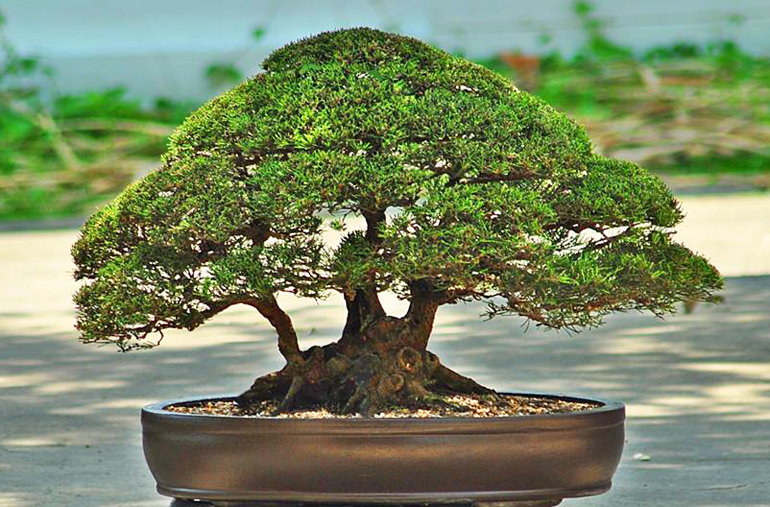
Though I like all of what I've seen of Trang Jira's trees, this one, with its clean simple lines is a winner. The tree is a clump style Casuarina with a very impressive nebari. Casuarina is a genus. No species is given
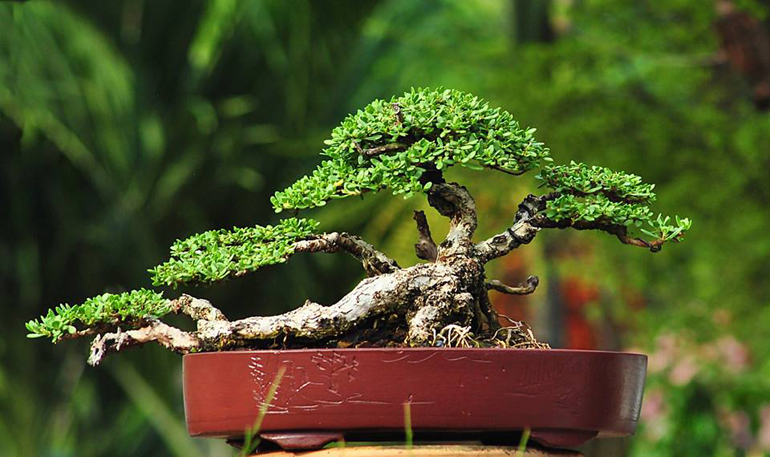
Reclining bonsai. It's another Pemphis
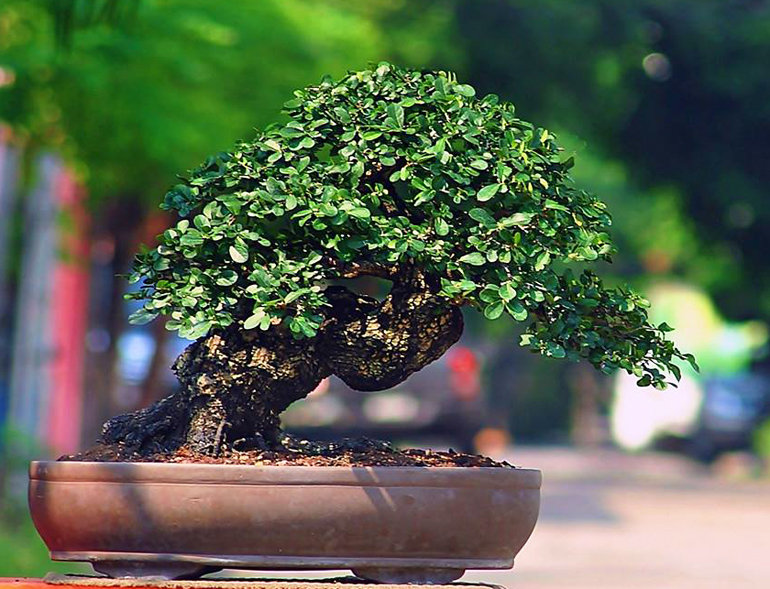
A little more conventional* than the others, but the strong undulating trunk with its textured bark is still pretty impressive. It's one of the numerous species in the Diospyios genus. Trang Jira doesn't say which
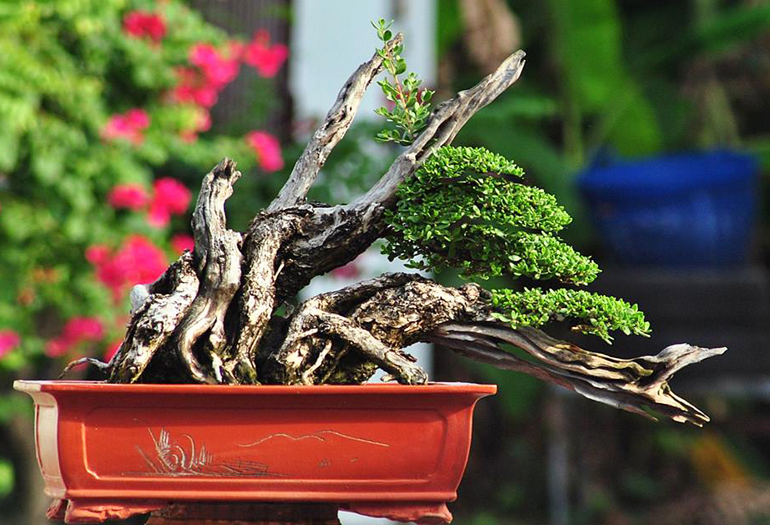
Stacked. The trunks and the foliage pads seem to mirror each other. It's another Pemphis
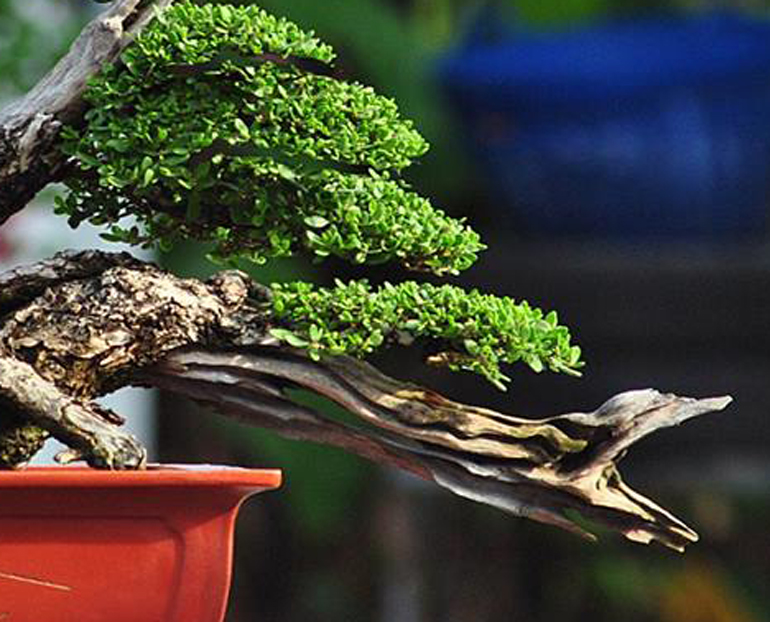
Close up of the pads and strange beast sticking out on the right. Can't decide if it's a snake or baby bird with a long neck
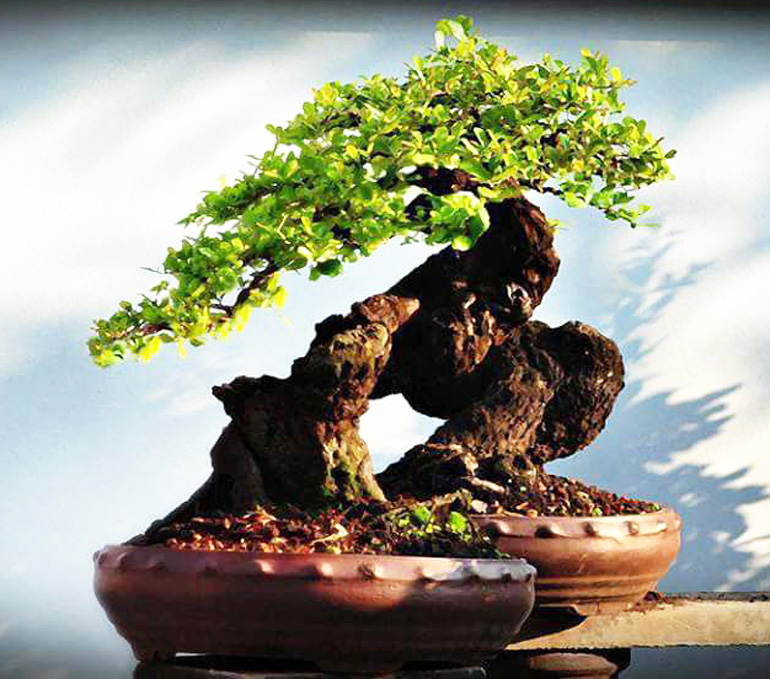
Is this one tree in two pots? Or do you need new glasses? Until right now, this was the only Trang Jira tree we’ve shown here on Bark. It’s from a post we did last August titled ‘Is This Really One Tree in Two Pots?‘ It’s another Diospyios
*In North America and much of the West, the art of bonsai is heavily influenced by the Japanese bonsai tradition.
A Magnificent Celebration of American Bonsai Coming Soon
Winner of the Finest Bonsai Masterpiece at the 5th U.S. National Bonsai Exhibition. It's a Mountain Hemlock (Tsuga Mertensiana) that belongs to Eric Schikowski. The photo is by Joseph Noga as are all the photos in Exhibition Albums 2-5.
Just a friendly reminder…
It’s time to make your plans. The 6th U.S. National Bonsai Exhibition is the premier North American celebration of bonsai. The one event you don’t want to miss and it’s only a little more than two months away. We look forward to seeing you there!
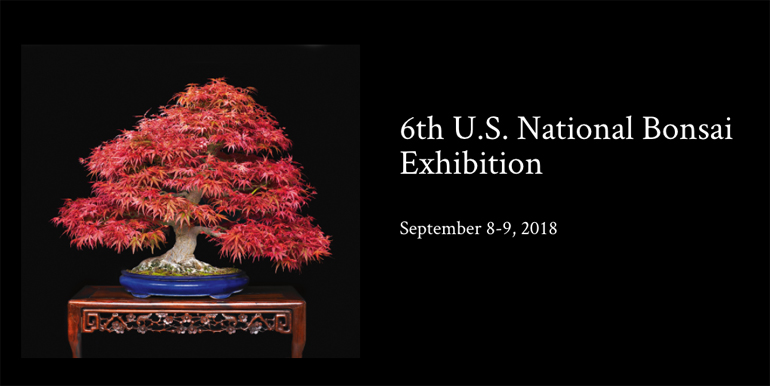
Time to register and make your accommodations plans and Bill Valavanis has all the information you need right here
This Colorado blue spruce won the All American Award (Finest American Species in an American Container, Displayed on an American Table) at the 5th U.S. National Bonsai Exhibition. It belongs to Jason Eider.

Another Colorado blue spruce. This one won the ABS North American Bonsai Award at the 5th U.S. Exhibition. It belongs to Todd Schlafer
The following is from Bill Valavanis’ Exhibition website…
“The world bonsai community will once again be enriched by the display of bonsai gathered from across the United States at the 6th U.S. National Bonsai Exhibition, September 8-9, 2018, in Rochester, NY.
“Like Japan’s Kokufu Bonsai Exhibition, people from around the world attend the U.S. National Bonsai Exhibitions to appreciate and study the diversity of the unique and distinctive species displayed by accomplished bonsai artists from across the United States.
“Towering bonsai from the Pacific Northwest, rugged bonsai from the Rocky Mountains, and tropical bonsai from the Southern swampy regions will be displayed alongside weathered bonsai from the Southwestern deserts and refined deciduous bonsai from the Northeast.”
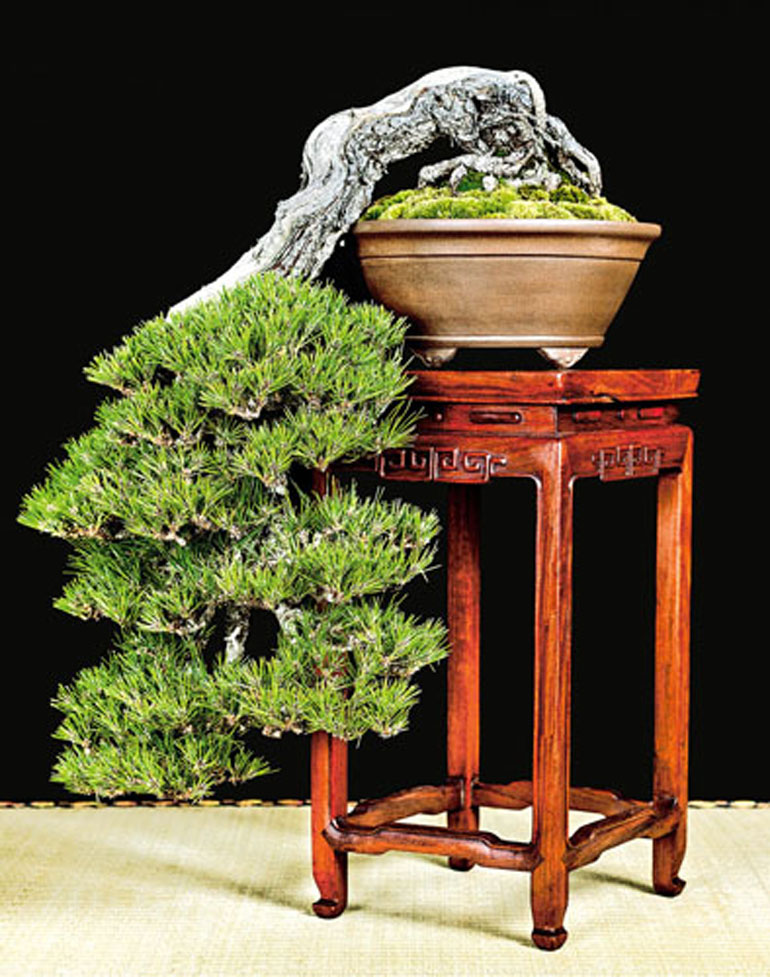
Immigrant species are welcome. This Japanese black pine is also from the 5th U.S. National Exhibition. It belongs to John Kirby. You can find it and over 200 other distinctive bonsai in the 5th Exhibition Album. We still have some albums from the 4th Exhibition as well (1,2 & 3 are sold out, and according to Bill, there are no plans to reprint)
About 6 weeks ago I dug about 70 field grown trees (mostly Larch) from my land and put them in training pots. My plan is to offer some of them at the upcoming 6th U.S. National Bonsai Exhibition in September. Almost immediately after digging they started rooting and pushing healthy new foliage. Now, it’s time to fertilize, so today they’ll each get a handful (more or less depending on the tree’s size) of Green Dream Fertilizer pellets, with an application of Micro Total to follow next week.

I’ll continue to use Green Dream, Dyna-gro Bonsai Pro liquid and Micro Total through the summer, tapering off in August to just a couple light applications of Green Dream and Micro Total in order to slow growth and hopefully end up with nice tight foliage for the show.
We look forward to seeing you there!
–
Bonsai Boon with and without Flowers
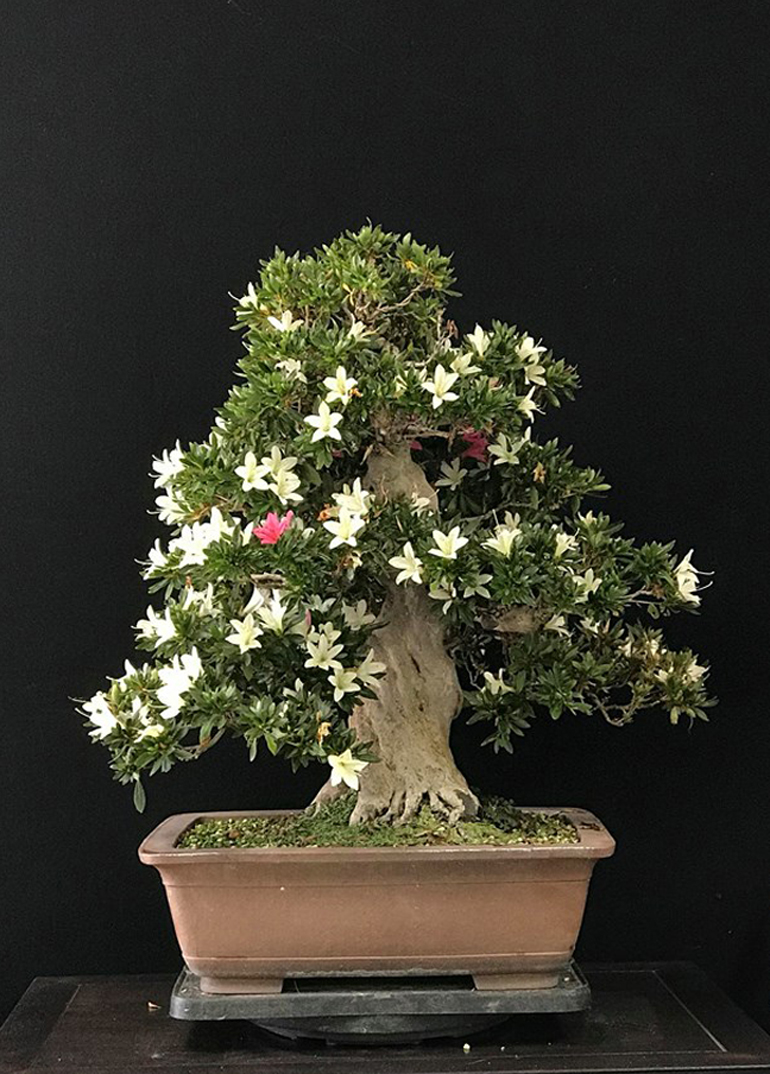
This powerful old Satsuki azalea belongs to Boon Manakitivipart. The shot was taken just before spring pruning. Boon's caption with this shot and the one just below is... "Satsuki azalea Debloom and thinning"
Boon Manakitivipart (Bonsai Boon) is one of our favorites and has appeared numerous times here over the years. In addition to being a highly accomplished and prolific bonsai artist, Boon is teacher to many of the best American bonsai artists. The photos shown here were taken from Boon’s timeline. Three of them are first timers here.
You might notice that flowers were removed during spring pruning on this Satsuki azalea (see photo just below). Heavy pruning is often done in the spring when plants are most vigorous. This helps insure speedy recovery and allows plenty of time for next year’s buds to set. In this process, it’s not unusual to remove this year’s blooms. Hopefully after you’ve had a little time to enjoy them. –
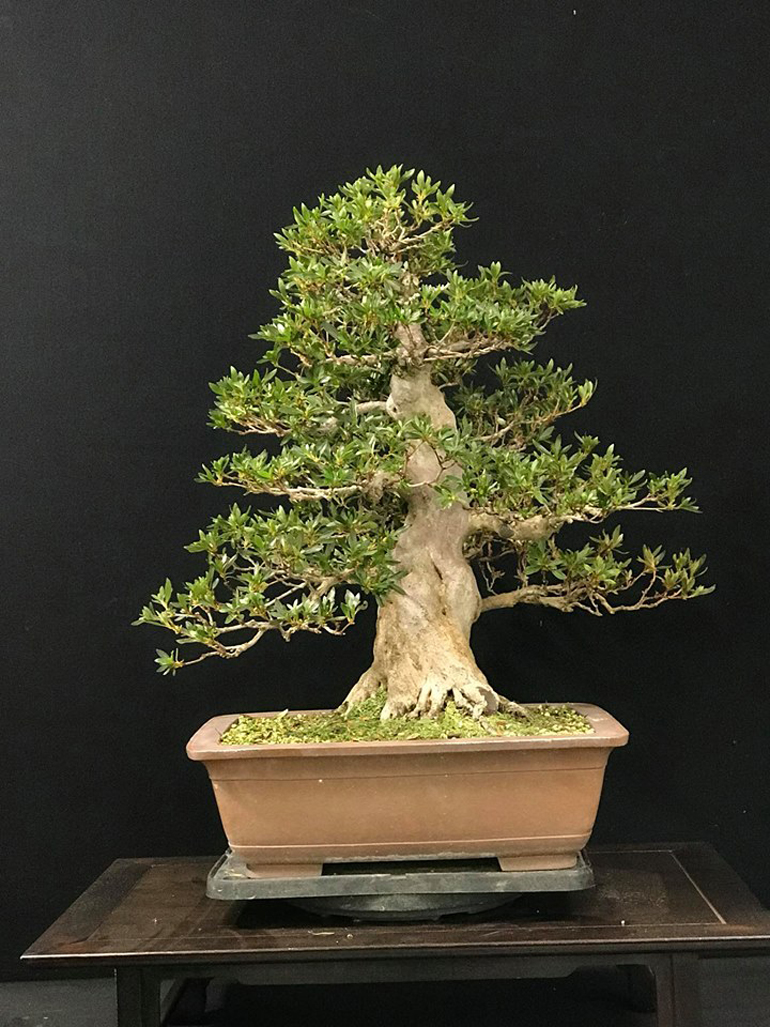
After pruning. It almost seems a crime to remove the beautiful flowers, but sometimes the long term wins out.
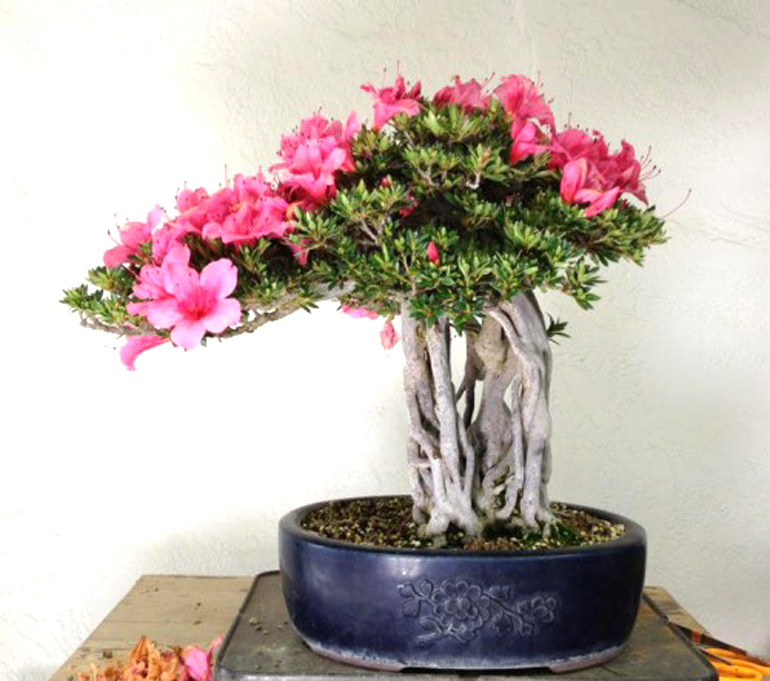
Another of Boon's Satsuki azaleas. I borrowed it from our archives. Here's our original caption... "This Satsuki azalea’s trunk reminds me of some of Antoni Gaudi’s sculptural architecture that graces the great city of Barcelona. Though in truth, the tree resides in Boon Manakitivipart’s impressive bonsai collection in the great city of Alameda, California" (Boon has since moved to Hayward, another Bay Area City).
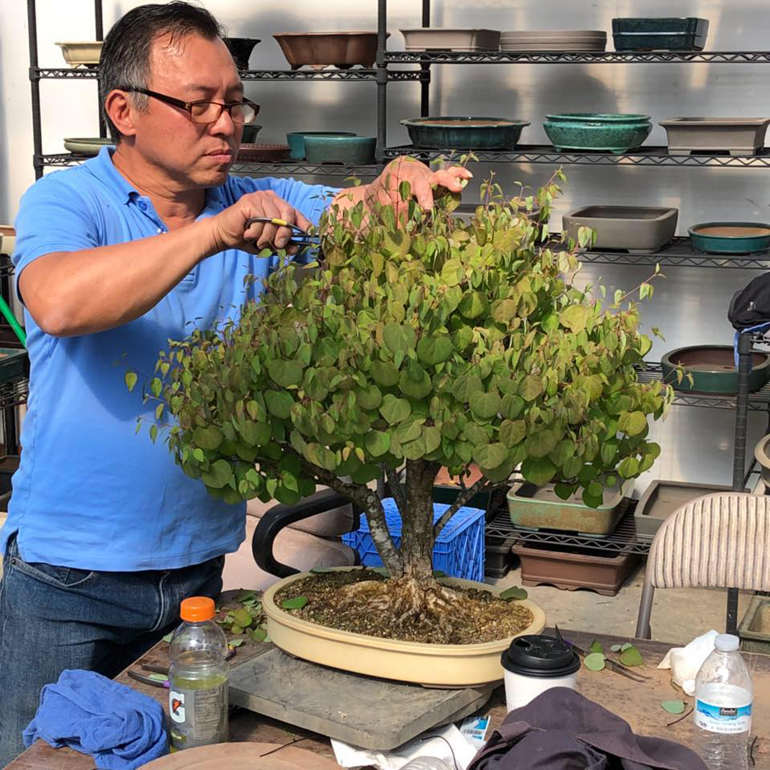
Boon at work. He doesn't say what the tree is. The leaves look like they might be Katsura, but there are other type trees with heart shaped leaves, so don't take my guess to the bank
Elevating a Root-on-Rock Bonsai
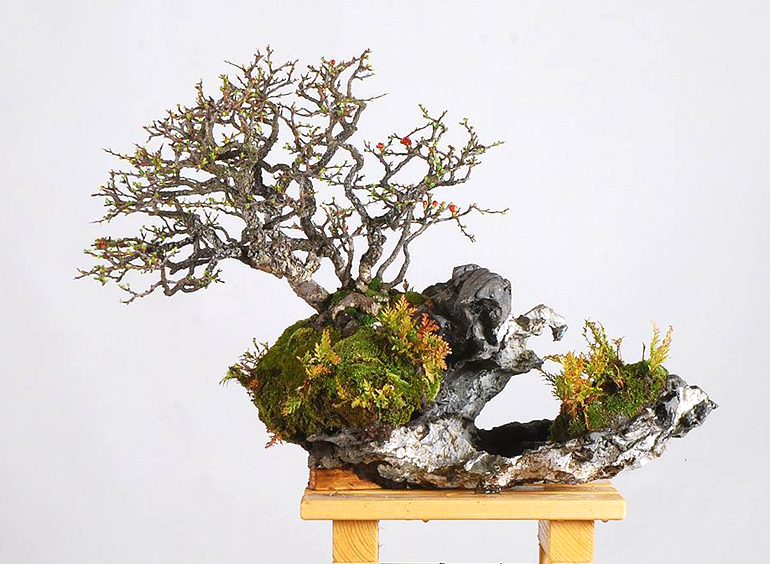
With bonsai, it's almost always the tree that dominates, even though the pot, (stone, slab or whatever) is considered a critical part of the whole. In this case however, it's the rock that elevates the planting to extraordinary. Or, you might say it's the rock and the way it's adorned by the old tree along with the moss and ferns, that makes this planting extraordinary. The tree is a Japanese quince (Chaenomeles japonica). The tree, rock and moss belong to David Benavente.
Staying close to theme, we’ll move from root-over-rock bonsai to root-on-rock bonsai. This post is from July, 2015, with some value added today–
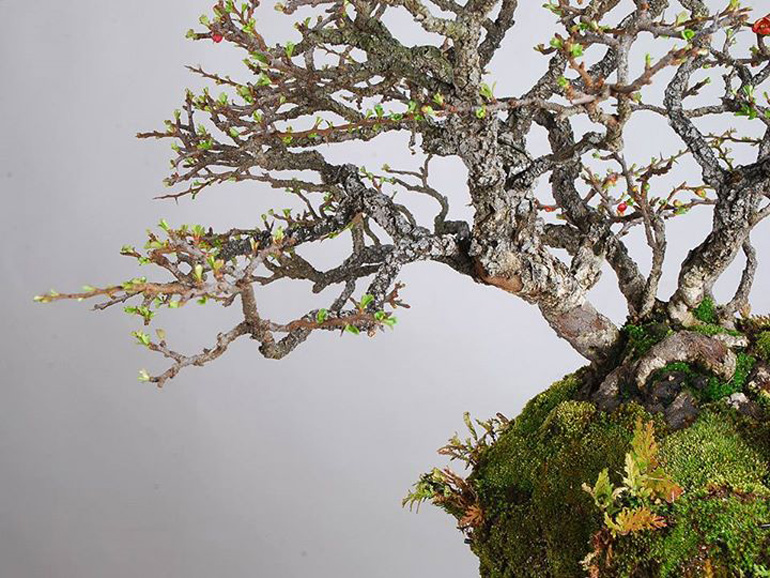
In this close up the bark speaks of great age and the tree's precarious position and gnarled shape tell a story of hard times and survival.
–
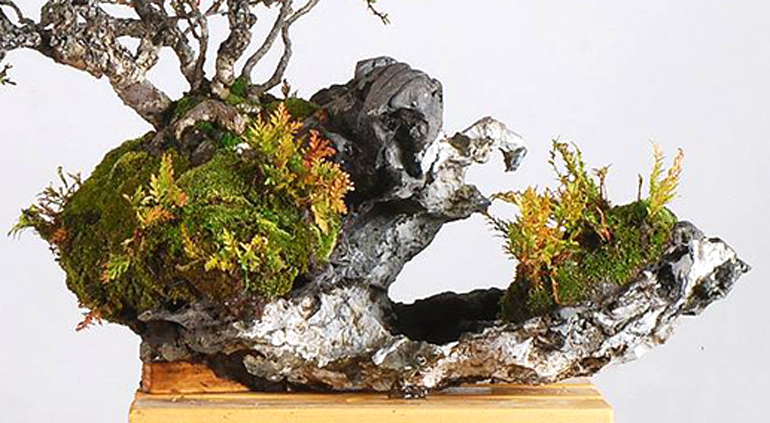
The rock!
–
Here's an equally impressive and improbable Benavente planting. The main tree seems so relaxed and natural given its precarious position. It's a Scot's pine (Pinus sylvestris) and the others are Japanese quince (Chaenomeles japonica). As with the planting above, there are also ferns and moss. I'll guess the convex slab is man made. Speaking of convex, how does that fern underneath ever get enough light?
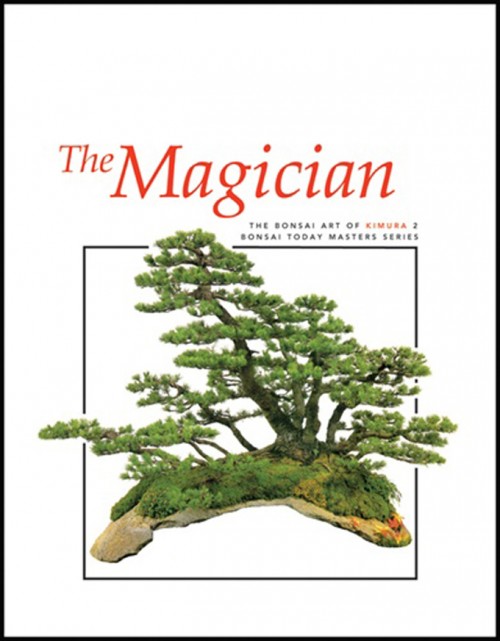
As long as we're talking about root-on-convex slabs, here's a famous Japanese white pine planting by Masahiko Kimura that graces the cover of our also famous Kimura (aka The Magician) book.
A Different Kind of Root-over-Rock
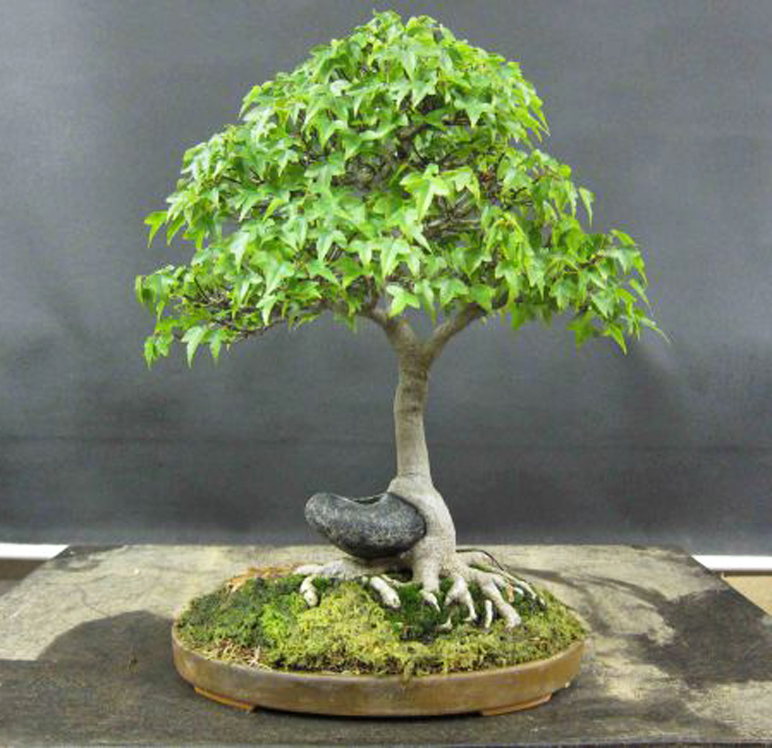
A strange sort of root-over-rock. You might imagine that it started more or less like other root overs, but because the rock is so small, the roots grew under it and pushed it up, while also growing around one side and creating a firm grip on the rock. Though I originally thought the result might simply be an happy accident, upon reflection I think it was the intention of the original artist 40 to 50 years ago.* It's just too perfect the way most of the rock, particularly the bowl is left uncovered and even emphasized. Like so many root-over-rock bonsai, the tree is a Trident maple
Continuing with our Root-over-rock theme from the last two days. The photos and some of the text featured here are from Peter Tea’s blog ( August, 2012). Peter has been featured several times here on Bark.
Peter Tea is a very good story teller and the story that goes with this tree is no exception. We’ll offer a taste here and if you’d like you can read it all and see some more photos on Peter’s blog
Continued below…
–
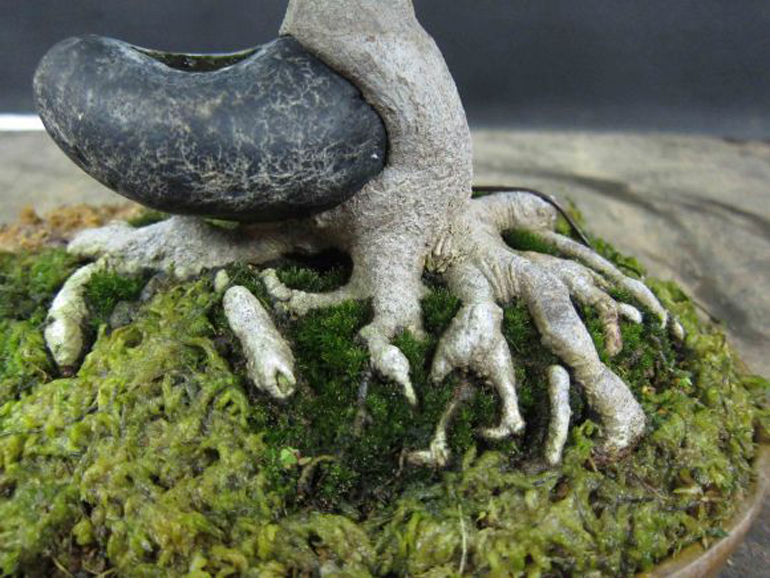
Close up. Such a unique look. The rock is well chosen with it's mini pond (for small birds and other critters to grab a drink?) and the nebari might be best describe as gnarly. Or maybe gnarled? Or both.
Continued from above in Peter’s own words …
“This Trident Maple came to the yard about 3 months ago and is one of the trees I water on a regular basis. It belongs to another professional and is being kept at the nursery for the time being. As I walk by the tree, I always admired the strange stone that the tree is growing around. One day I asked Mr. Tanaka about the stone and if it’s the reason why there is some value in this tree and he quickly pointed out that this was a great tree and that the stone had little to do with it.”
Continued below…
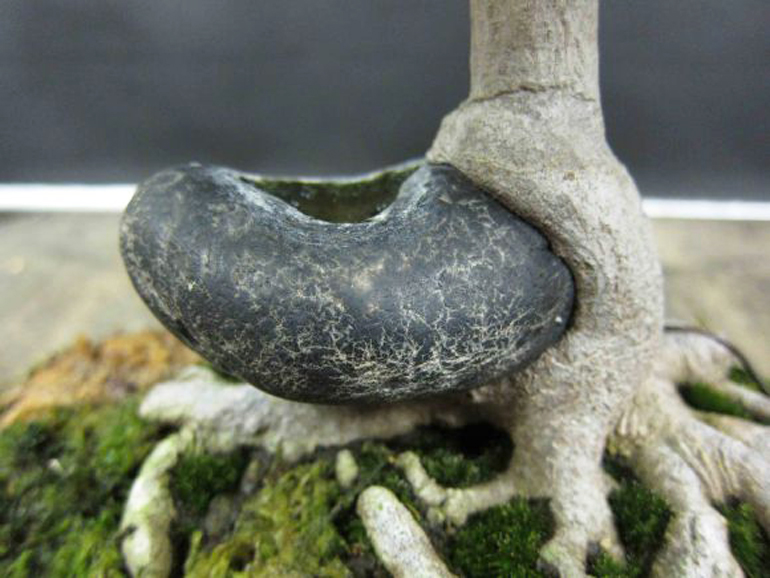
Closer up
Peter continued…
“I was a bit surprised when he said that and it got me to examine the tree more closely. As I sat in the workshop looking at the tree, I started to realize why this tree is quite nice. Mr. Tanaka pointed out a few things and then went on to say, “Only crazy Bonsai people can understand this tree, this tree has Great Taste!” Wow, I really needed to examine what this tree is all about. I went ahead and took some photos of different areas of the tree so you too can see what makes this tree special. We are in for a treat because a tree like this is not easily duplicated or found.”
Continued below…
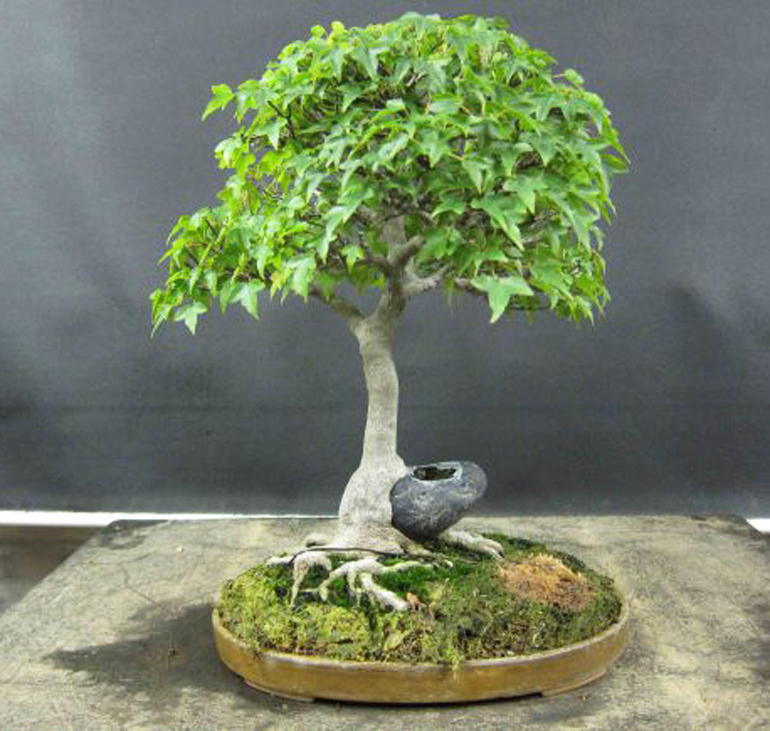
The back is pretty impressive too and quite similar to the front at a glance. Though looking a little closer, the differences begin to stand out.
Peter continued…
“The main reason why this tree is prized is the age. Looking at the characteristics of the tree roots, trunk and branches tells us that this small tree is actually 40-50 years old! The stone then adds that extra bit of charm that makes this entire tree interesting and desirable. Lets take a closer look at the little things that tell us this tree is old…”
For the rest of the story, visit Peter’s blog
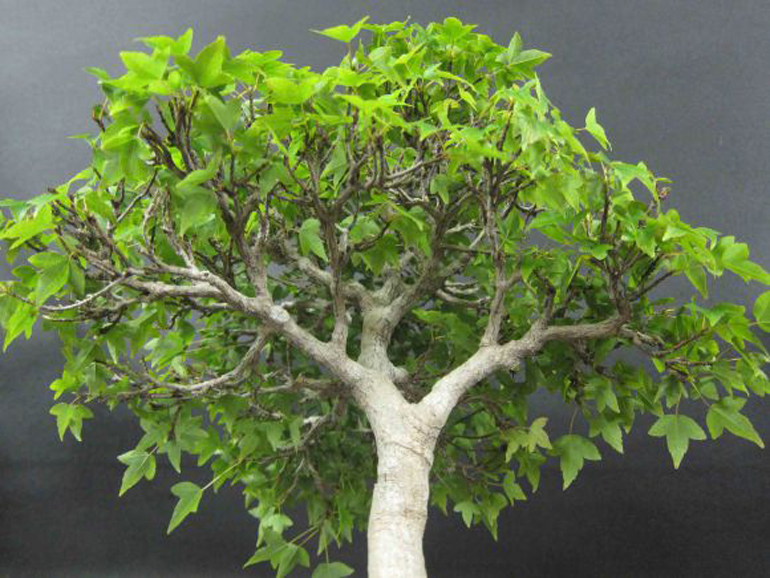
Looking up into the branching. This branching plays into Peter's story about the age and worthiness of this tree
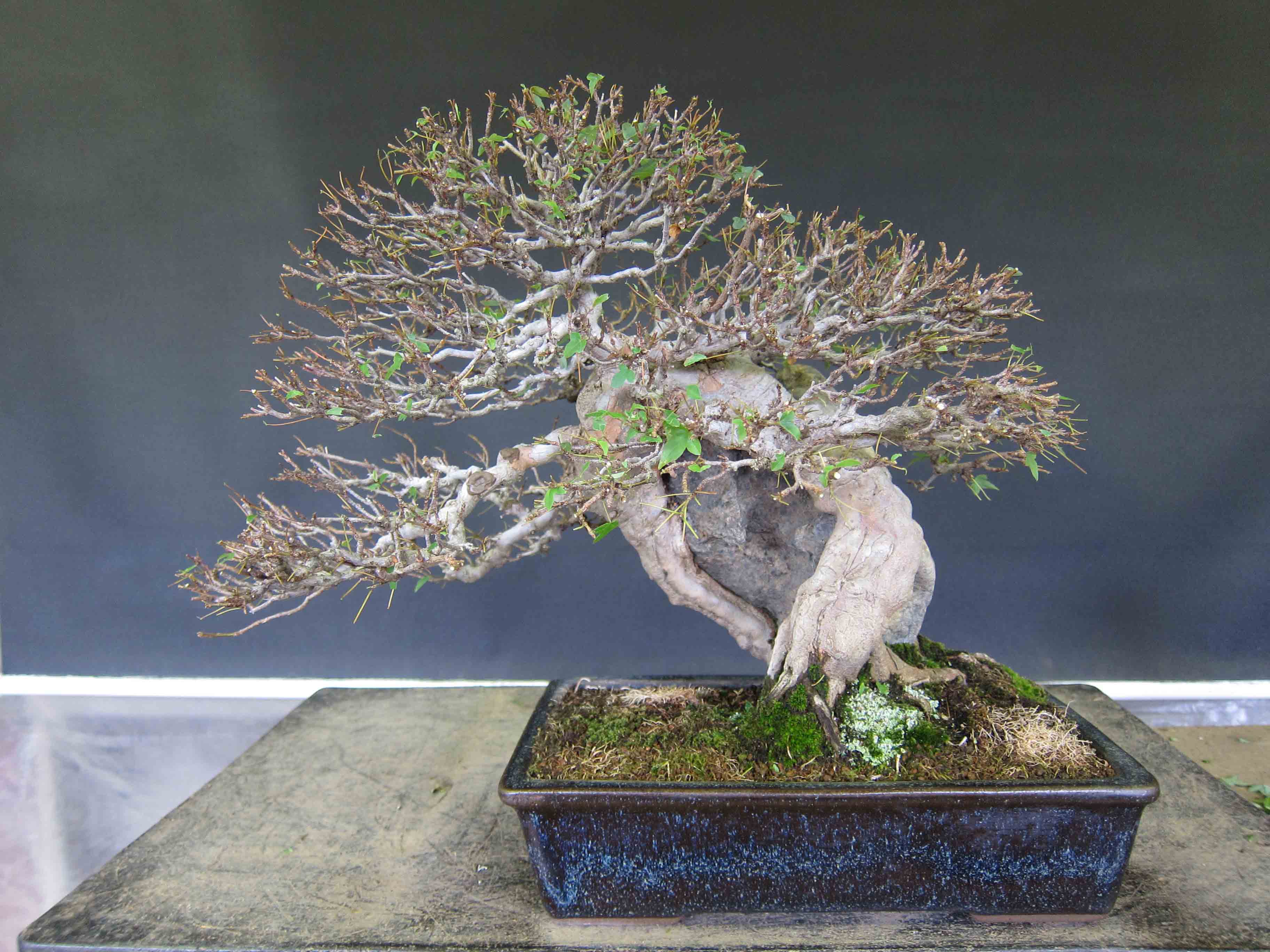
Rock swallowed by roots. Another Trident maple from Peter's post.
*40 to 50 years old according to Mr Tanaka, Peter’s teacher.
Great Root over Rock Bonsai
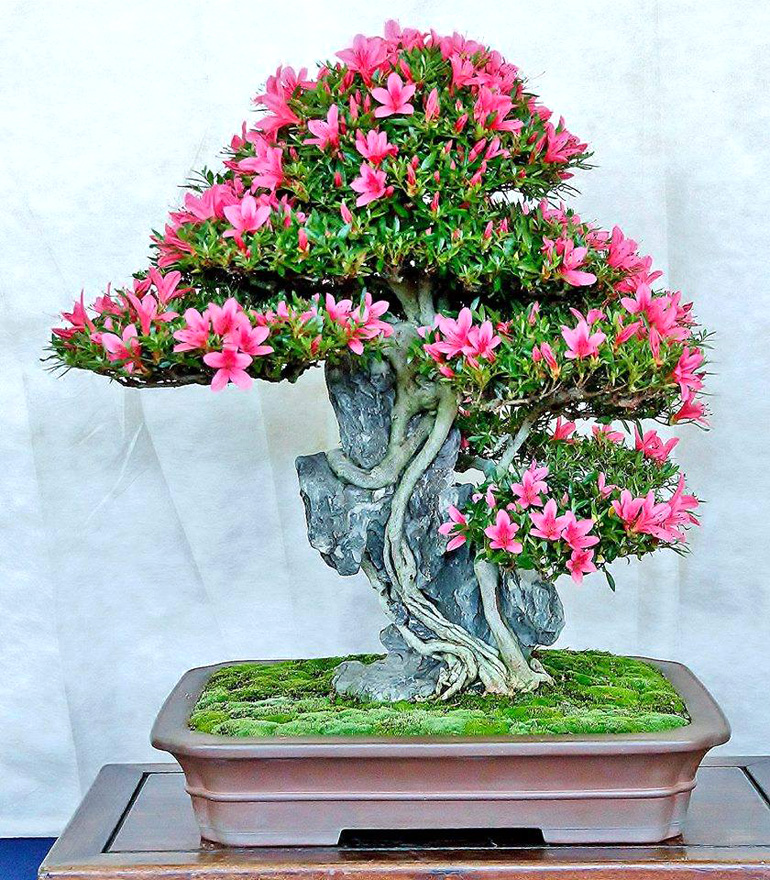
No source is given for this colorful 'Seki-joju' Azalea. My best guess is that the tree and photo are originally from Japan; it's not uncommon for Japanese trees to remain unattributed (this is often the case in the Japanese gallery section in Bonsai Today magazine back issues). We found the photo on Bonsai Addicted's timeline.
Yesterday we featured a magnificent root-over-rock bonsai by Marvin Besa from the Philipines. Here’s a post devoted completely to Root-over-Rock bonsai that we originally featured a year ago.
This Trident maple root-over-rock by Wolfgang Putz has to be on my top 100 bonsai photos list (if I had such a list). It originally appeared in a 2014 Bark post.
Here's one that started as a root-over-rock and slowly morphed into a root-swallowing-rock (not an official designation, just an observation). It's another Trident maple (the most commonly used species for root-over-rock) originally from Kaede Bonsai-en.
Yet another Trident. You can imagine that if you removed the branch on the right and cut the one on the left back to where it emerges from the crown, this strange tree would look a whole lot more like so many other conventionally designed bonsai. But don’t do it! Who wants a conventional bonsai when you have a tree so strikingly unique and impossible to forget? The photo is from the National Bonsai Foundation’s 2013 calendar.
This unusual root-over bonsai with its dramatic gongshi type stone appeared in a post we did on Stewartias back in 2013. The photo is originally from Bonsai Today issue 24. Photo by Kindai Bonsai, courtesy of Bonsai Focus.
“One Quick Glance at this Tree Brought Me to a State of Nirvana”
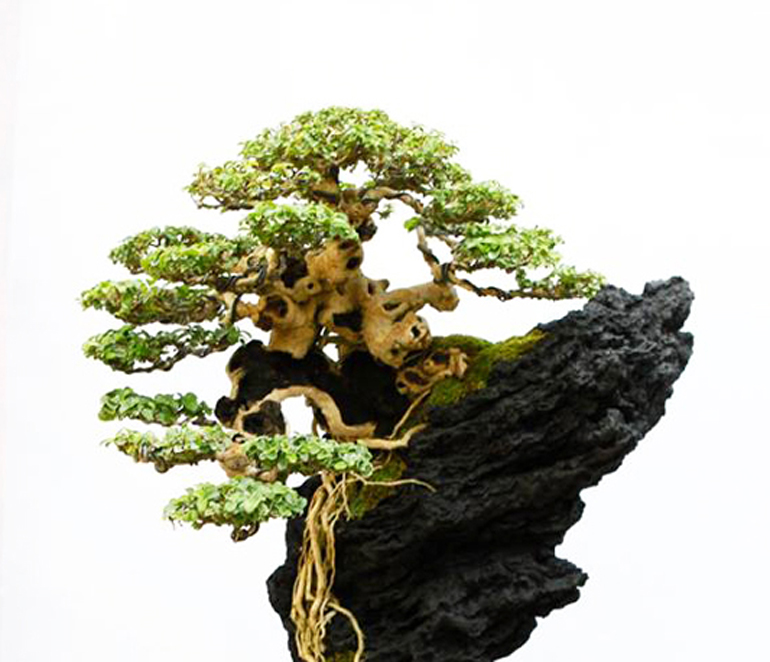
A close up of a rather spectacular root-over-rock bonsai (the entire planting is just below). Here's our original caption (from May, 2016) with some changes made today...Robert Steven(my mistake, see below) has done it again. This time it's a perfect root-over-rock bonsai. Here's what Charles Bevan has to say about it: "This is unbelievably perfect. One quick glance at this tree brought me to a state of nirvana."
I was looking to continue our forest theme when I ran across this post from last year (and the year before). There is a forest (below), but it’s the feature tree and the title of the post that caught me. As usual, I’ve done a little adding and subtracting.
When we originally found the three trees shown here on Robert Steven’s timeline we assumed they belonged to Robert (always assume assumptions are mistaken). Here’s the real story sent to us by Tab Aquino. “These trees are from the Philippines. The rock-grown tree is a Vitex trifolia owned br Marvin Besa. The “juniper” (see below) is actually a Pemphis acidula owned by Alexis Perez.“
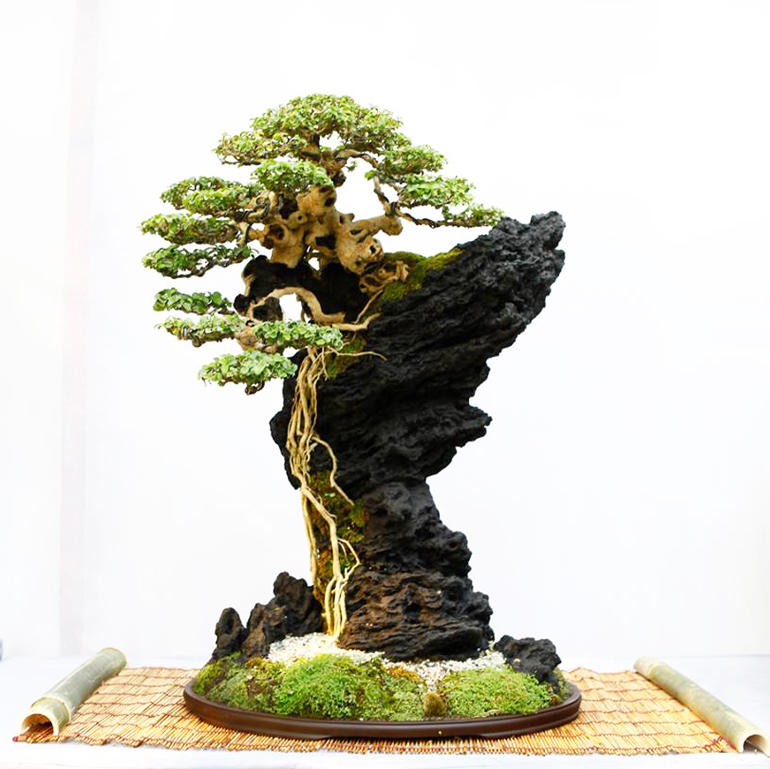
There are root-over-rock bonsai and then there are root-over-rock bonsai. I think it is safe to say that you will seldom see one quite as spectacular as this one. Nor one with such long thin roots supporting the tree.
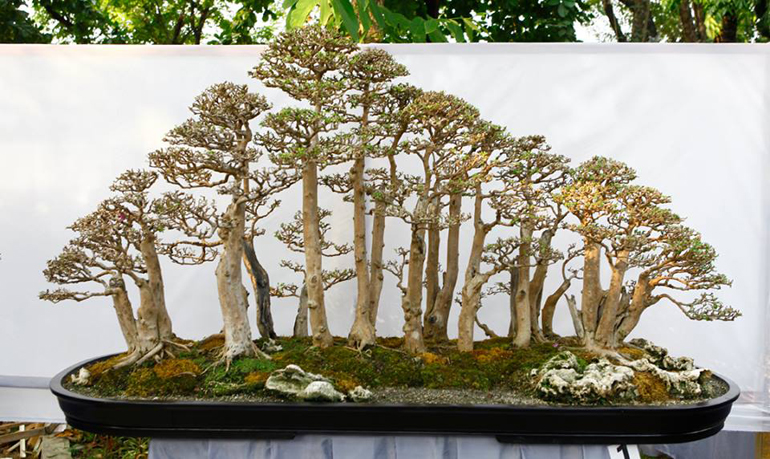
Tab didn't say, so we don't know what the trees are. However, we do know that this is a very large, powerful and well done forest planting. And we might assume (there's that word again) that such a huge pot costs a small fortune.
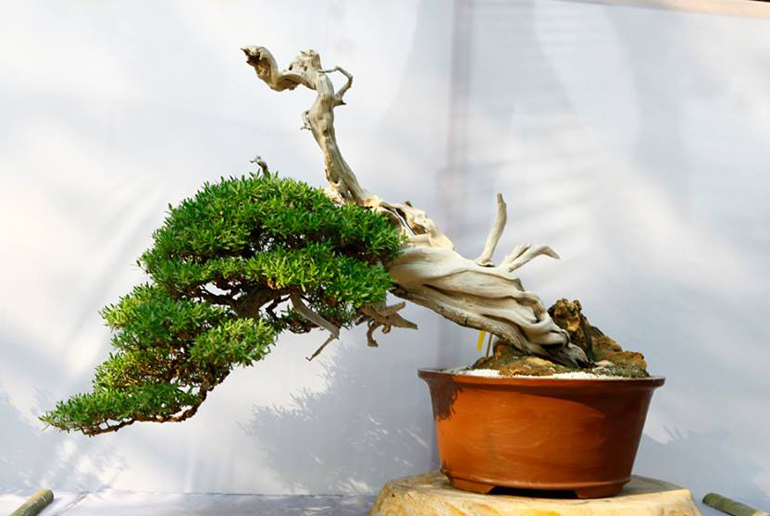
This is not a juniper in spite of what you might think and in spite of what I thought until Tab Aquino set me straight (see his comments above). It's a Pemphis acidula
The Magician’s Formal Bonsai Forest
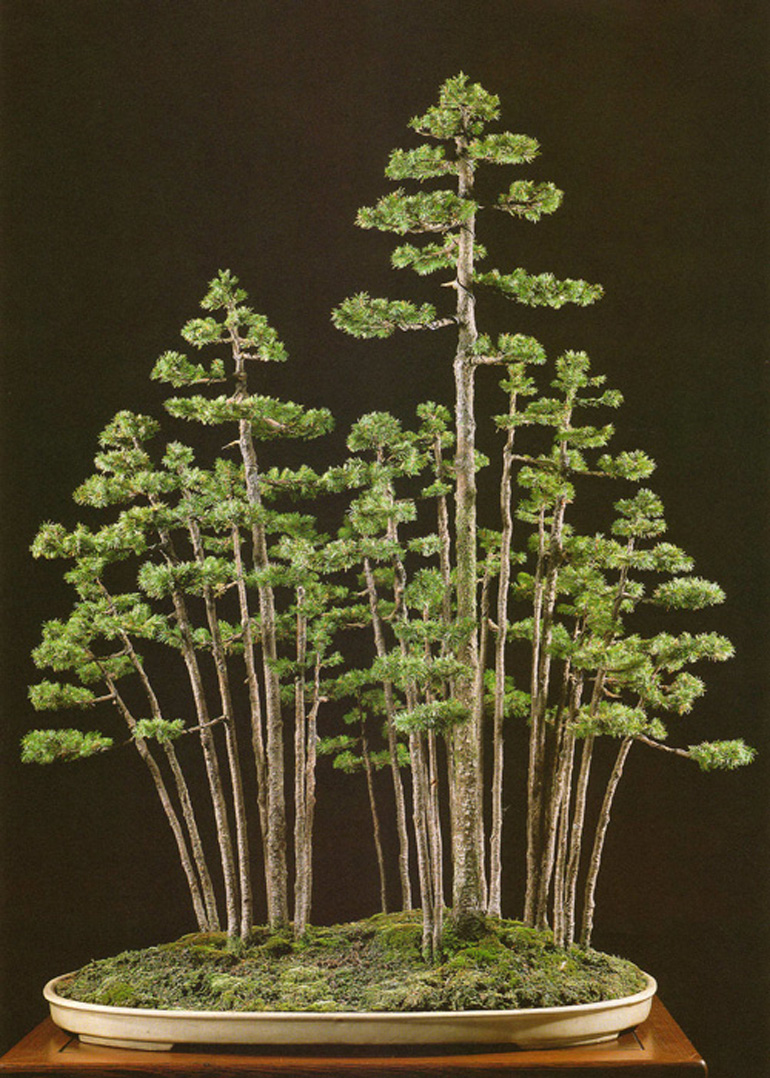
Masahiko Kimura 'The Magician' styled this Ezo spruce (Picea Glehnii) planting with a high mountain stand of conifers in mind (this shot is three years after the initial planting and two years after the intermediate shot - both are below).
Much of this post is from 2009 (our first year blogging). I’ve added some photos today and revised and added to the text. I hope these changes are helpful.
Looking at the forest above, you might notice how the trees on the outside lean out in search of sunlight, which is what you would expect in a natural stand of trees. You may also notice how Kimura enhanced the feeling of age by removing or jinning about half of the limbs (compared to the intermediate shot below). Trees tend to shed limbs as they age. This is especially true of trees in forests where there’s competition for light; with more growth at the tops and edges and less in the shaded areas where branches tend to weaken and even fall off. All three photos in this post are from Bonsai Today issue 26*
–
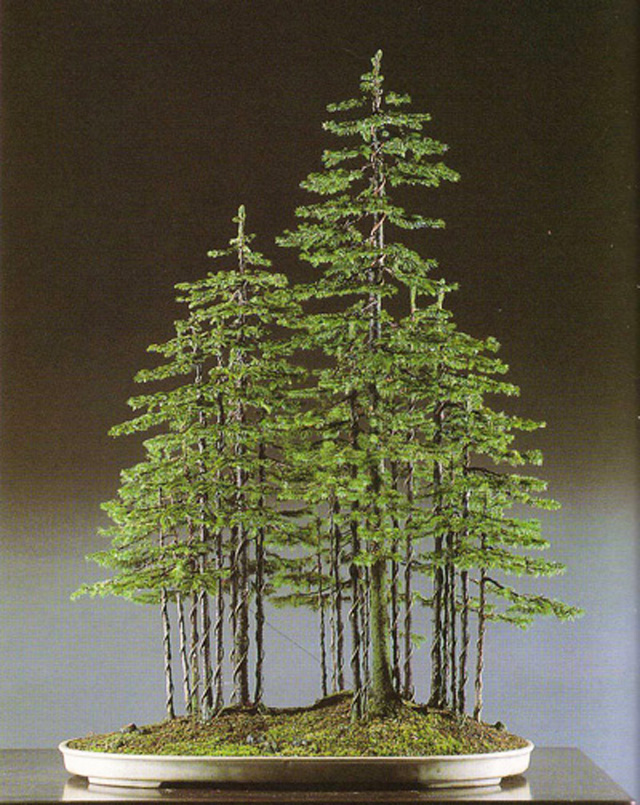
It's amazing what wire can do in the right hands. This intermediate stage is one year after planting (below) and two years before the top photo. It's quite powerful at this stage and I suspect most of us would be delighted to have a forest like this exactly as is. Notice how each trunk is wired and all are almost perfectly straight and vertical. One of the next steps will be to bend and lean the outer trunks and make more subtle adjustment to the inner ones.
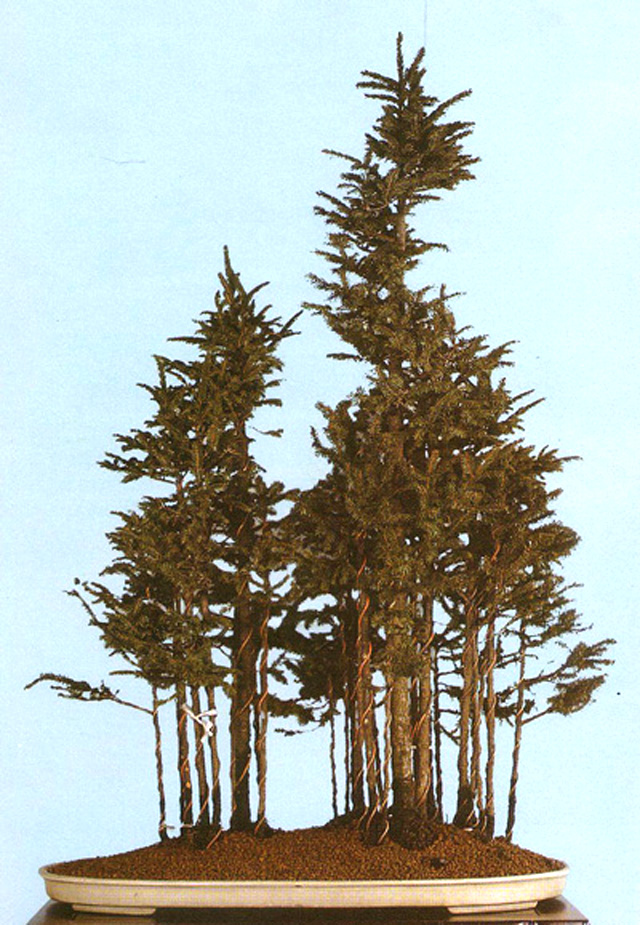
Freshly planted. Kimura started with inexpensive, untrained trees. The placement of each tree is carefully thought out to create a natural and harmonious feel. We'll discuss some of the concepts behind placement in future posts. Meanwhile, an excellent book on the subject is Saburo Kato's Forest, Rock Planting & Ezo Spruce Bonsai.
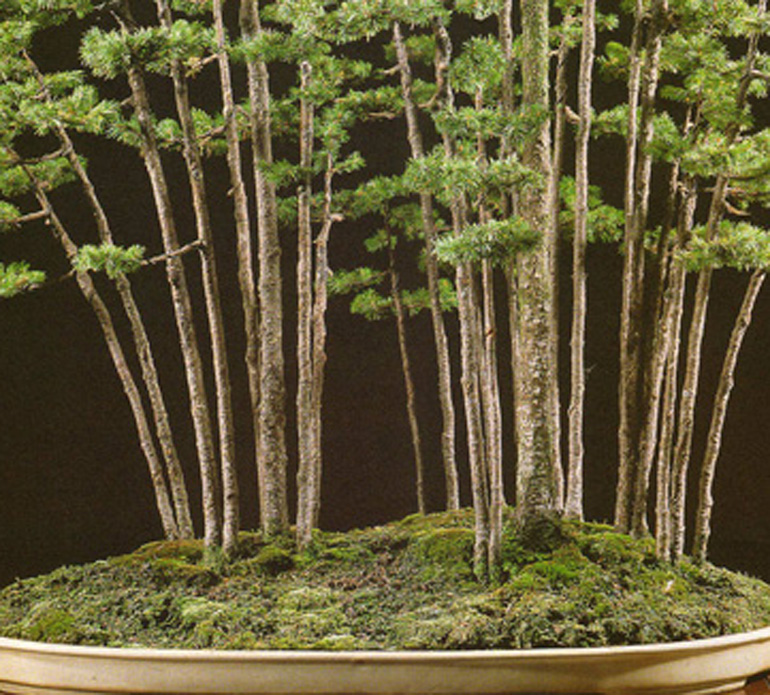
A closer look at the trunks and ground cover
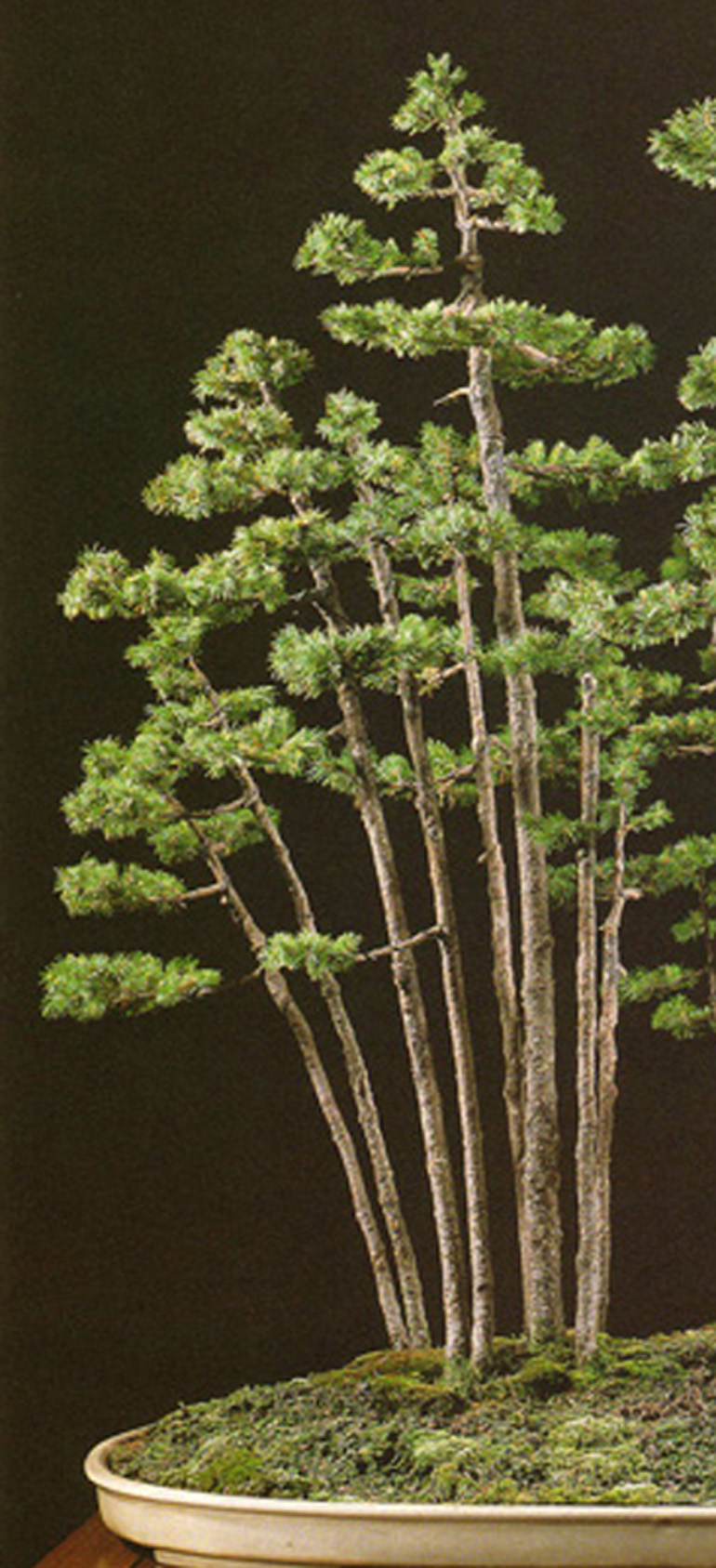
Close up of the left grouping
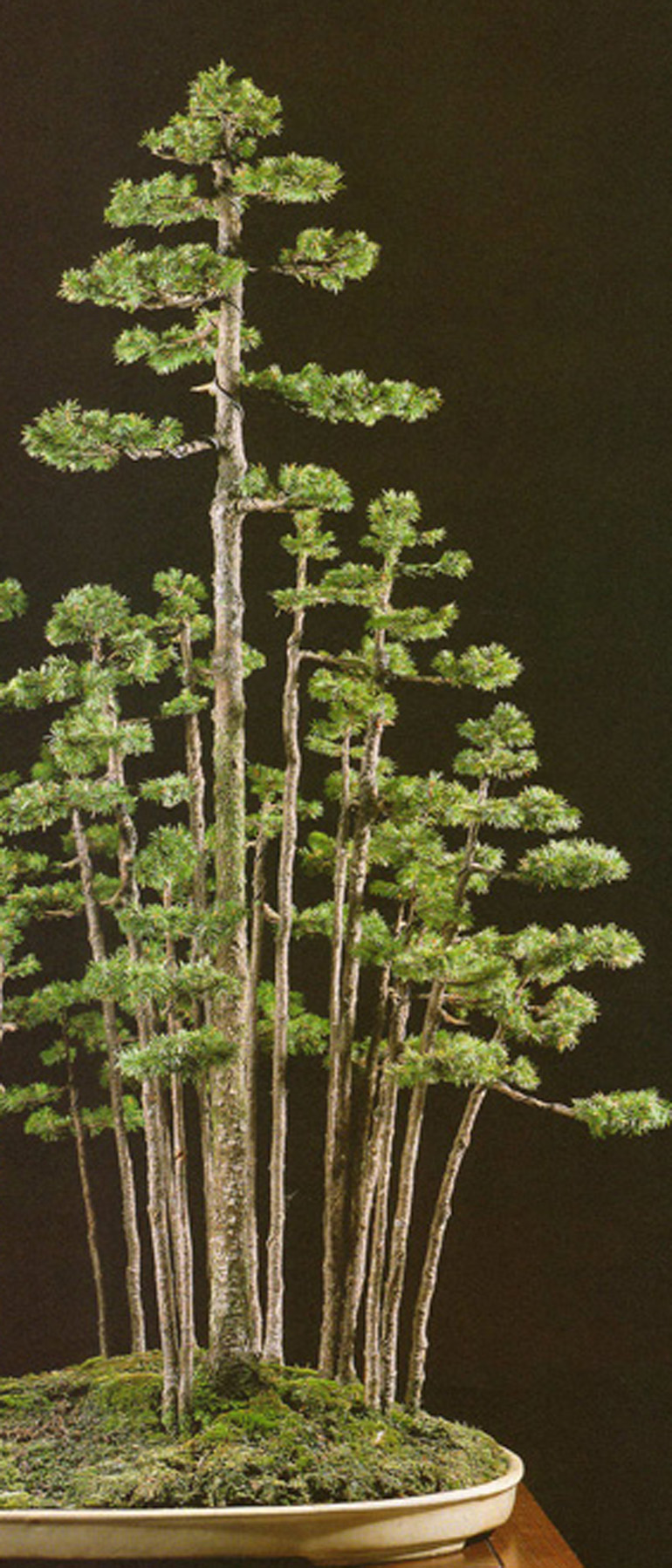
The right grouping
*The photos in this post are originally from Kindai Bonsai and are shown here courtesy of Bonsai Focus
Challenges All Their Own – Mixed Bonsai Forests
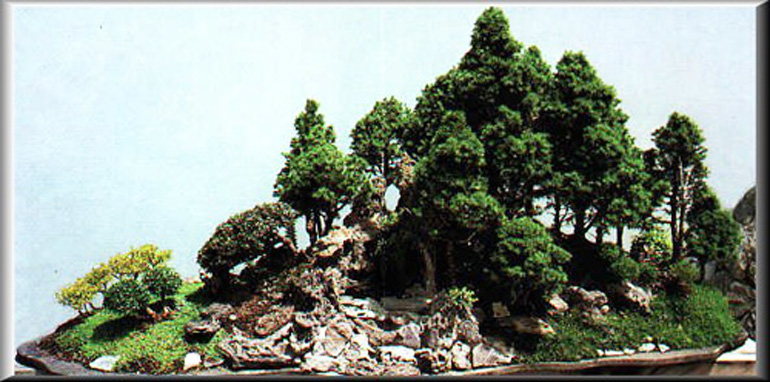
This mixed forest/landscape is from Spain. The Museo del Bonsai Marbella to be exact (from Bonsais del Sur). It's too bad the pot is chopped off and the whole photo is cramped, but that's the way we found it. Still, from what we can see, it look s like a very ambitious project with a numerous type trees and other features to integrate. No mean feat to pull off
Today we’ll stay on our forest and other multiple trunk theme of late, only this time it’s mixed bonsai forests from mixed sources. Mixed forests present challenges all there own and are not as common as single variety forests
Forests with mixed species can be a little tricky; not only does the planting have to make sense aesthetically, particularly when it comes to questions of scale, but the various types of trees should make sense growing together (would you find them growing together in nature?) Not that you can’t experiment with trees that normally might not grow in the exact same locations, but the more different their natural habitats are, the more unnatural the planting might seem and the more difficult it is to keep all the trees healthy.
This mixed forest is one of my favorites. It’s from Saburo Kato’s Forest, Rock Planting & Ezo Spruce Bonsai (published by The National Bonsai Foundation and distributed by Stone Lantern).
Here's the cover. The forest in this case is all one species; Ezo spruce, a favorite of Kato's. This beautifully done, classic book is one of the best bonsai forest books, if not one of the best bonsai books period.
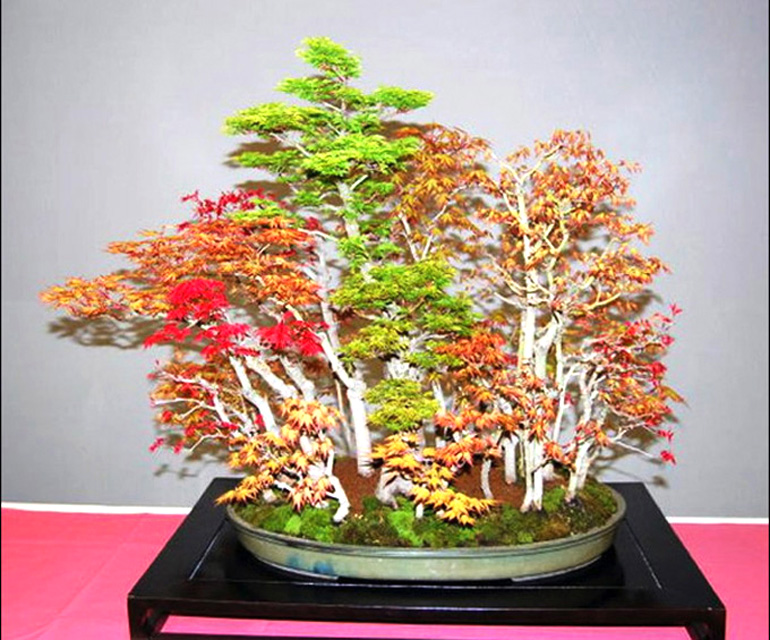
This swirl of colors is a different kind of mixed forest. All the trees are one species (Japanese maple) but there are at least four or five different varieties. It's by Juan José Bueno Gil. Note: I'm not sure why the trunks are so white. Not something you'd expect with Japanese maples. Maybe someone fiddled with photoshop a little too much?
More Impressive Works of Imagination & Skill
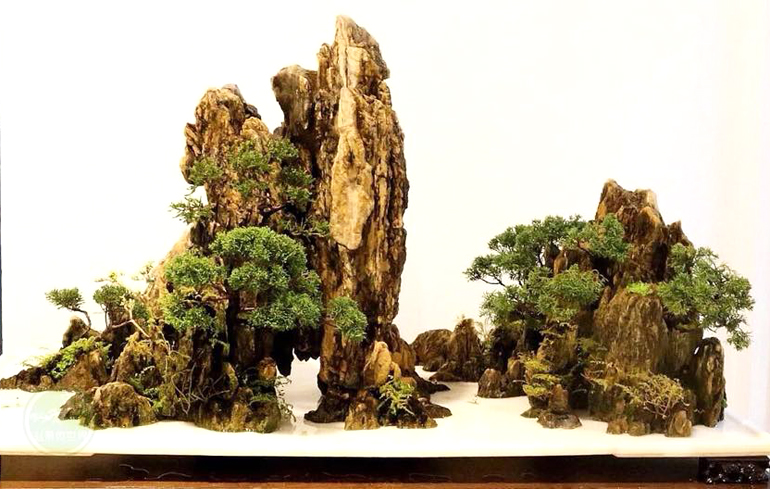
This Penjing landscape features exceptionally rugged terrain and no immediately visible sign of humans. Or are there one or two tiny almost indistinguishable specks of something that could be man made?
Continuing where we left off yesterday. For some reason I got a little fascinated with the man made elements; mostly small boats and buildings. I think maybe it’s the perspective they provide. Tiny beings in a vast wild world. Anyway, with or without signs of human activity, these rugged and realistic Penjing landscapes are impressive works of imagination and skill
All the photos are borrowed from Hong Kong Bonsai Pots. No artists or plant varieties are mentioned
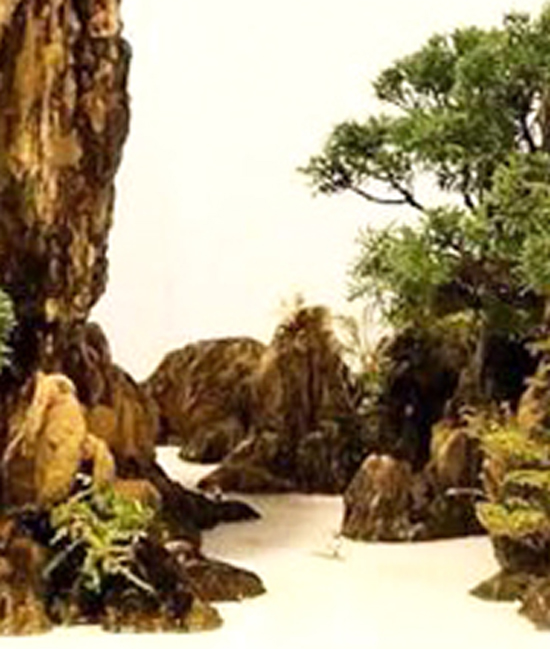
Closeup from the photo above. Is that a boat?
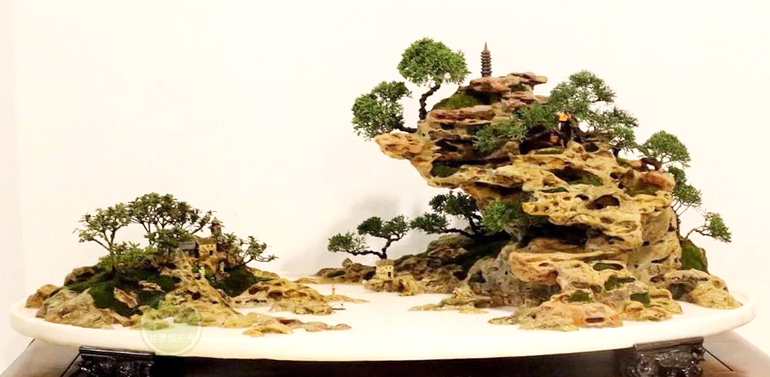
Unlike the one above, there are plenty of signs of human presence in this one.
A closer look at the cave covered mountain from the photo above.
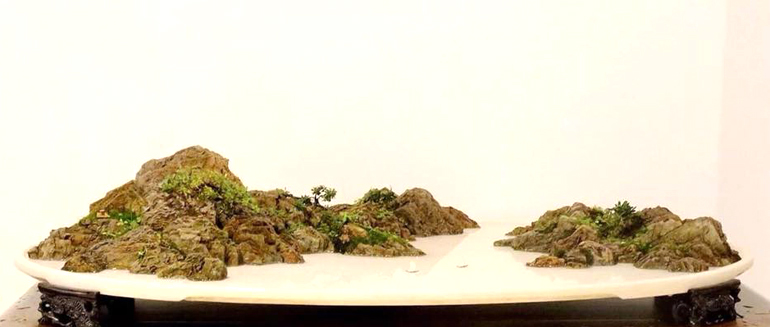
I like this one's understated beauty and simplicity, with almost no sign of humans
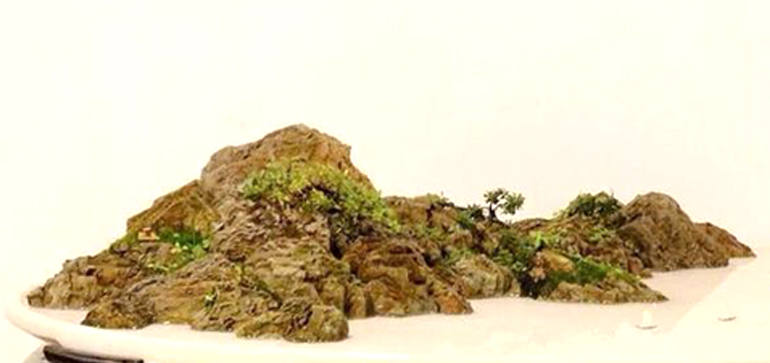
A closer look. You can see the building in the whole landscape above, but can you make out the boats?
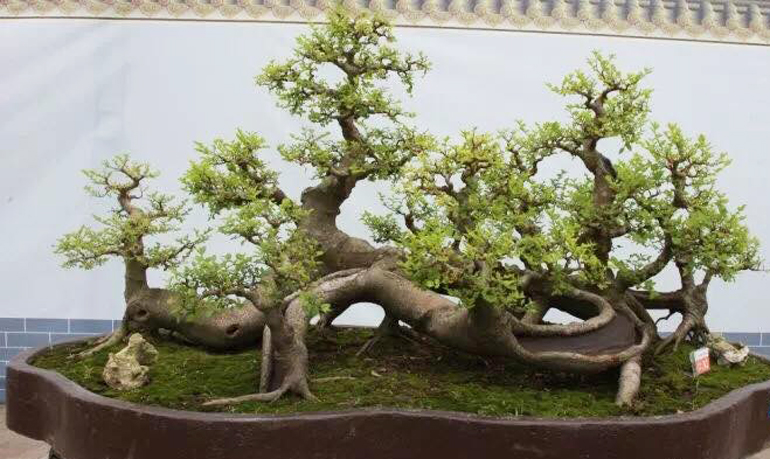
A little change of pace. There's no mention of plant variety, but the bark and what we can make out of the leaves looks like a certain type of Chinese elm.

